As the seasons change in Grinnell, long walks in the sun are exchanged for cozy, sweater-clad nights inside. No matter where you’re located in the world right now, take this opportunity to spice up your time in the kitchen with some of these favorite dishes, ranging from the sweet to the savory. The following recipes were all submitted by Grinnell students and cover a range of dietary restrictions, so there’s something for everyone to enjoy.
Soy Free and Vegetarian SunButter Noodles
Sophie Jackson ’22, International Relations
I made this dish for the first time a few months ago. Because I am allergic to soy, I have not been able to have Asian noodles for several years (they used to be one of my favorite foods). When my housemate told me that there was a good soy sauce alternative (coconut aminos), I was suspicious but very excited. I made this dish the first time I tried them out and it turned out to be delicious!
Ingredients
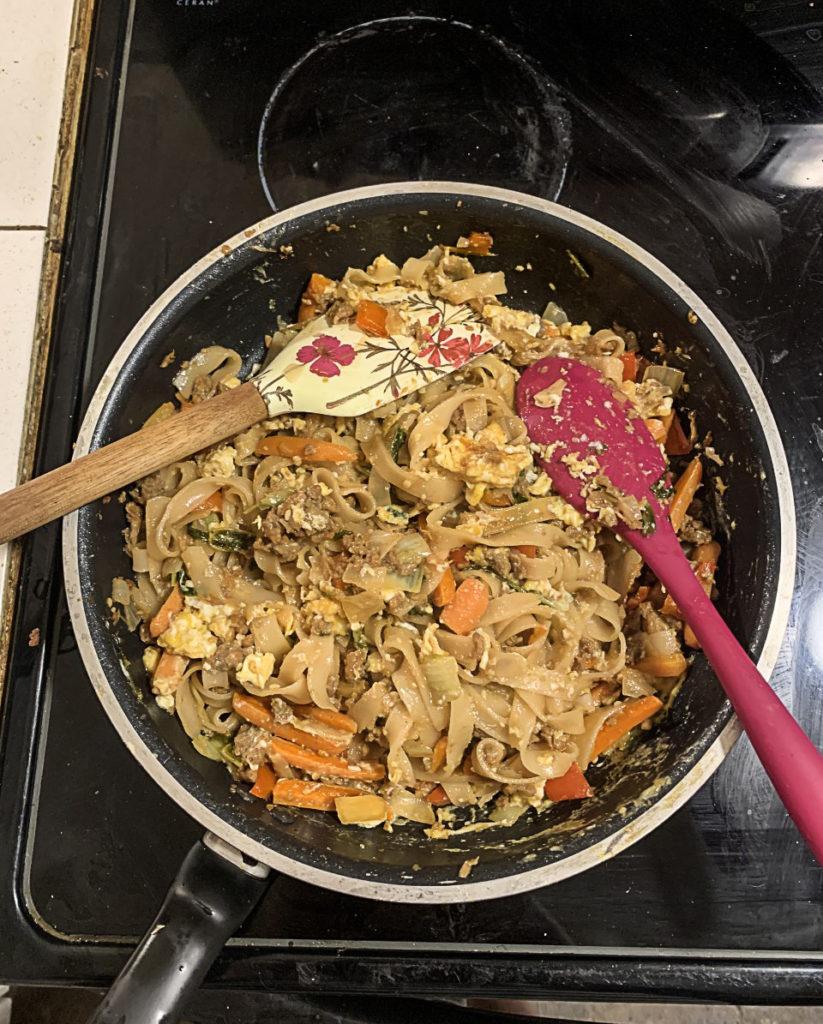
Rice noodles (however many you desire)
Onion
Garlic
Peas
Chinese cabbage or bok choy
Red pepper
Beyond Meat
Eggs
Bean sprouts
Green onions
Peanuts
Coconut amino acids
Rice wine vinegar
Brown sugar or tamarind
Fresh ginger
Fresh garlic
Sweet chili sauce
SunButter
Preparation
Step 1
Soak the rice noodles for 15 minutes in hot water.
Step 2
Saute onion, pepper, Chinese cabbage, peas and garlic in olive oil. In another pan, cook Beyond Meat.
Step 3
While meat and vegetables are cooking, prepare the sauce. Mix coconut aminos, rice wine vinegar, sweet chili sauce, garlic, ginger, brown sugar or tamarind and SunButter. Use a whisk or a fork to fully combine the SunButter with the rest of the ingredients.
Step 4
When ready, add the meat, some water and the rice to noodles to the veggies. Turn up to high in order to cook the rice noodles and burn off the extra water.
Step 5
Add the sauce and fully combine with ingredients.
Step 6
Scramble eggs separately and then combine.
Step 7
Add bean sprouts and top with crushed peanuts and green onion!
Notes from the chef:
Add any other vegetables you like, and exclude eggs for a vegan option. You can also exclude SunButter for a more pad thai-like option. If I do this, I like to add some pineapple juice to the sauce. You can also boil your rice noodles for a few minutes [instead of soaking].
Dubu Jorim (From Maangchi’s cookbook)
Priyanka Dangol `22, computer science
Dubu Jorim (두부조림) was one of the first dishes I learned to make with my boyfriend. Ever since we started dating, he wanted to make me try some Korean food (he’s Korean), but since Grinnell didn’t have any Korean restaurants, he decided that he would purchase the ingredients online and we could make the dish together. The first time around, although it didn’t taste as good, I loved the flavor of the Korean red pepper so much – it was unlike any other type of pepper I’d had, and I couldn’t wait to make it again. This is one of our favorite dishes to make as the steps aren’t really complicated and we love tofu! I also went on to make this for Food House guests two times and it was a big hit.
Ingredients
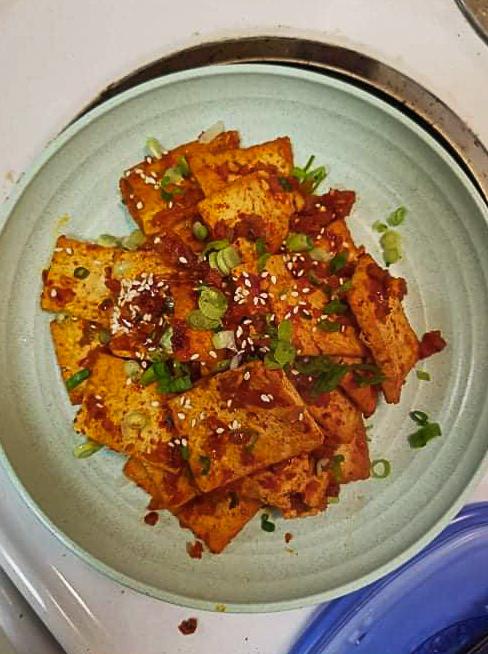
1 package of tofu (18 ounces: 510 grams)
3 tablespoons cooking oil
1 teaspoon sesame oil
1 teaspoon sesame seeds
1 clove garlic, minced
½ cup onion, minced
2 green onions, chopped
For the sauce, mix in a small bowl:
1 tablespoon soy sauce
1 teaspoon salt
1 teaspoon sugar
1 tablespoon hot pepper flakes
½ cup water
Preparation
Step 1
Rinse tofu in cold running water and dry it with a cotton cloth or paper towel. Cut it into ¼ inch-thick bite-size pieces.
Step 2
Add the cooking oil to a non-stick pan and heat it up over high heat.
Step 3
Gently set the tofu onto the pan and cook for 7 to 8 minutes. Rotate the pan to cook the tofu evenly. When the bottoms get a little crunchy, flip them over one by one with a spatula. Let cook another 7 to 8 minutes until both sides of each piece of tofu are a little crispy and golden brown.
Step 4
Transfer the tofu to a plate. Keep the leftover oil.
Step 5
Heat up a small pan over medium-high heat and add the leftover oil.
Step 6
Add chopped onion, garlic, and green onion (less than one tablespoon, the rest will be used for a garnish later). Stir with a wooden spoon for a few minutes until the onion gets a little crispy.
Step 7
Add the sauce and keep stirring until it reduces a bit and thickens.
Step 8
Add tofu and braise for one minute until the tofu absorbs some of the flavors of the sauce. Add some sesame oil and stir.
Step 9
Sprinkle some sesame seeds over top and add the rest of the chopped green onion. Serve right away with rice.
Cranberry Sauce
Andrew Tucker ’21, biology and economics
My mom always makes cranberry sauce and has since I was super young. Since I’m not home for Thanksgiving, this is the first time I’ve made it.
Ingredients
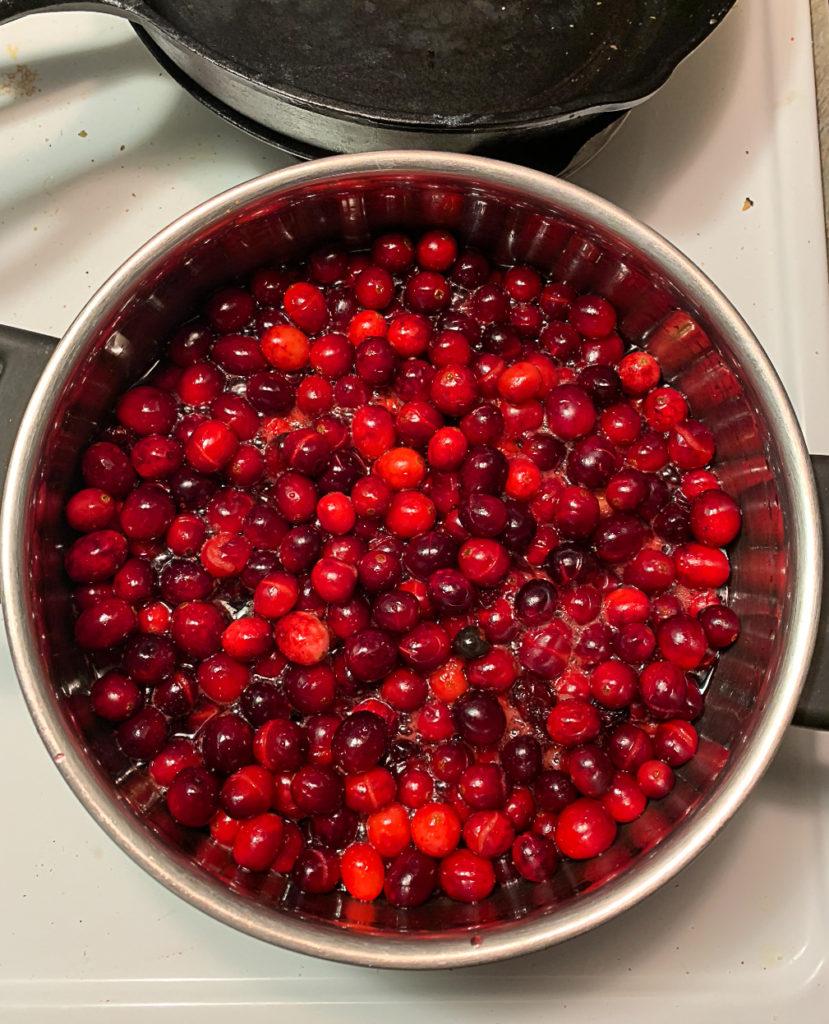
1 cup cranberry juice concentrate
½ cup dried cranberries
1 bag (12 ounces) fresh cranberries
½ cup sugar
3 tablespoons orange marmalade
3 teaspoons orange zest
3 tablespoons orange juice
½ teaspoon allspice
Preparation
Step 1
Add concentrate, dried cranberries, fresh cranberries and sugar to pot and heat over medium heat for 15 to 20 minutes (or until fresh cranberries have “popped” and are tender).
Step 2
Remove from heat and stir in orange marmalade, orange zest, orange juice and allspice.
Step 3
Transfer to a bowl or container and place in refrigerator until fully cooled.
Editor’s note: Andrew Tucker is the Visual Editor for The S&B.
Gingersnap Crusted Squash Pie
Rachel Eber ’21, anthropology
This is a gingersnap crusted squash pie recipe from my mom. It’s originally a pumpkin pie recipe, but I started experimenting with other kinds of squash in Food House after this one time that I was gifted a gigantic yellow squash that was just so big I didn’t know what else to do with it. The gingersnap crust is also really incredibly delicious. The picture is a version of the pie I made for my boyfriend’s birthday, decorated with some fall-themed chocolates.
Ingredients
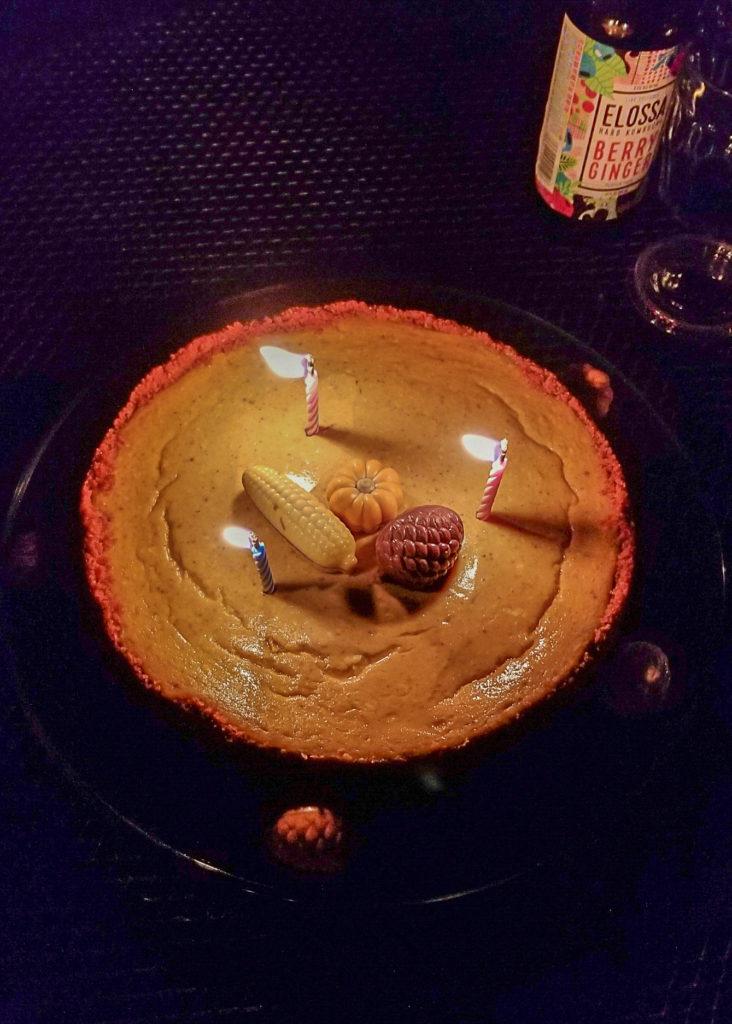
8 to 12 servings
¼ cup (½ stick) unsalted butter
8 ounces gingersnaps (about three cups)
1 tablespoon all-purpose flour
¾ cup plus one tablespoon sugar
2 large eggs
1 15 ounces can pumpkin purée
¾ cup half-and-half
1 ½ teaspoon ground cinnamon
1 teaspoon ground ginger
½ teaspoon salt
Pinch ground nutmeg
Pinch ground allspice
Pinch ground cloves
Preparation
Step 1
Heat the oven to 350°F. Melt the butter in a small saucepan over low heat (or in a small bowl in the microwave).
Step 2
Break up the gingersnaps slightly; put them in a food processor and pulse until they are finely ground. Add the butter, flour and 1 tablespoon of the sugar. Pulse a few times to combine. Press the gingersnap mixture evenly into the bottom and sides of a 9-inch pie pan and bake for 5 minutes.
Step 3
Beat the eggs in a large bowl. Whisk in the remaining ¾ cup sugar and the pumpkin, half-and-half, cinnamon, ginger, salt, nutmeg, allspice and cloves.
Step 4
Transfer the pumpkin mixture to the crust and bake at 350°F until a knife inserted into the center of the pie comes out clean, about 1 hour. (The center of the pie will not be completely firm.)
Step 5
Cool thoroughly. Serve at room temperature or cover with foil or plastic wrap and refrigerate for up to a day before serving. You can store leftover pumpkin pie covered with foil or plastic wrap in the refrigerator for up to several days.
Black Bean Chili
Obuchi Adikema ’21, computer science and theatre and dance
This chili was part of the first meal that I cooked at Food House. Our house coordinator, who had not spoken to me much that semester, looked me in the face and told me, “This is delicious.” I beamed with pride. This chili brings people together.
Ingredients
Serves 8
½ cup olive oil
4 cups chopped onions
2 1/3 cups coarsely chopped red bell peppers (about 2 medium)
12 garlic cloves, chopped
4 tablespoons chili powder
4 teaspoons dried oregano
3 teaspoons ground cumin
1 teaspoon cayenne pepper
6 15- to 16-ounce cans black beans, drained, ½ cup liquid reserved
2 16-ounce can tomato sauce
Grated extra sharp cheddar cheese
Preparation
Step 1
Heat oil in a large pot over medium-high heat.
Step 2
Add onions, bell peppers and garlic; sauté until onions soften, about 10 minutes.
Step 3
Mix in chili powder, oregano, cumin and cayenne; stir for 2 minutes.
Step 4
Mix in beans, ½ cup reserved bean liquid and tomato sauce.
Step 5
Bring chili to boil, stirring occasionally. Taste and add any other seasonings that you want.
Step 6
Reduce heat to medium-low and simmer until flavors blend and chili thickens, stirring occasionally for about 15 minutes.
Step 7
Season to taste with salt and pepper. Top with grated cheese.
Bangladeshi Chicken Korma
Ahon Gooptu ’21, English and theatre and dance
This was originally my mother’s recipe, which I’ve adapted and – I think – made better! It looks like a lot of work but if you have the right spices, it’s really easy and really there is more walking away and waiting than actual cooking! The chicken korma is best served with rice, preferably basmati, and perfect for a light, home-cooked, yummy meal that hits all the right spots!
Ingredients
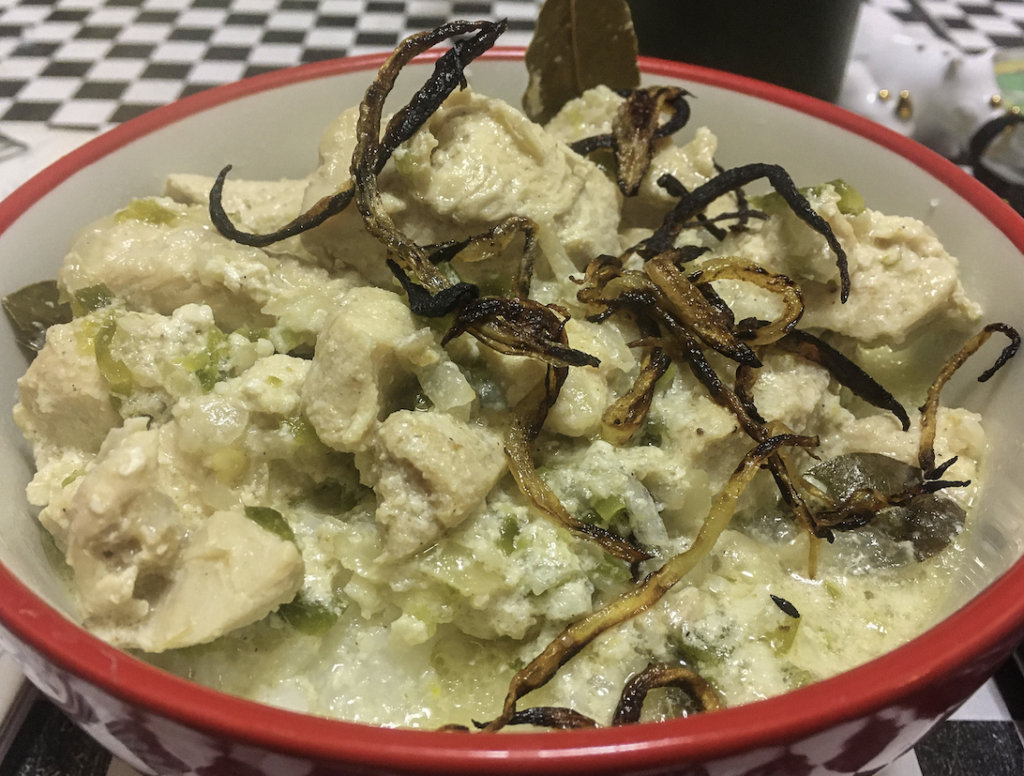
6 to 8 chicken thighs, cut into bite-sized pieces
2 tablespoons oil (vegetable or canola is fine!)
6 to 8 cardamom pods (optional, you can also grind this into a powder)
3 to 4 cloves
2 to 3 cinnamon sticks
4 bay leaves
1 large onion, finely chopped (you can also make this into a paste)
¼ more onion to fry for garnish (optional)
2 tablespoons ginger-garlic paste or, 6 garlic cloves, minced and 1 tablespoon ginger powder
1 teaspoon ground cumin
1 teaspoon ground coriander
1 ½ teaspoons garam masala powder (don’t add too much so that you get a lighter color)
4 green chillies, whole or 2 teaspoons red pepper flakes
4 tablespoons plain yogurt (not Greek)
¼ cup milk
2 teaspoons salt, or to taste (this will depend on the tartness of your yogurt)
1 to 2 teaspoons sugar, or to taste (also dependent on tartness of yogurt used)
1 ½ to 2 teaspoons lime juice, as needed
2 tablespoons water, or as needed
1 ½ cup rice, preferably basmati
Preparation
Step 1
Place a pot or deep pan over medium-high heat and pour in oil when the surface is sufficiently hot.
Step 2
If using the extra onions to fry for garnish, then add that now and fry for some time until brown and crispy. Remove and place aside on some tissue paper to soak the oil.
Step 3
Add some more oil if you fried the onions and then fry the cardamom, cloves, bay leaves and cinnamon sticks for about a minute to release the flavors. Be sure not to have the heat too high up at this stage. If it starts burning, it’s not a good sign!
Step 4
Add the onions and sauté until translucent and mostly cooked through, about 5 to 7 minutes.
Step 5
Add the ginger-garlic paste (or ground ginger and minced garlic), salt, cumin, coriander and garam masala and continue cooking for a few minutes, adding a sprinkle of water every now and then so that the mixture doesn’t get too dry or burn.
Step 6
When the oil has separated from the onion-spice mixture, add the chicken pieces.
Step 7
Cook the chicken on medium-high heat, stirring frequently, for about 5 to 8 minutes, or until it changes color and starts to release some water.
Step 8
Add the yogurt, milk, green chilies and sugar, to taste. Cook for several minutes until the liquids start to boil, about 6 to 10 minutes.
Step 9
Turn the heat down and simmer with the lid on for 10 to 15 minutes, or until the chicken looks tender and is cooked through.
Step 10
Remove lid and cook another few minutes to thicken the korma as desired. Add the lime juice.
Step 11
Taste and adjust seasonings as needed at this point, adding more salt, sugar and/or lime juice to balance out the flavors before removing from heat.
Step 12
Garnish with fried onions, if using, and serve hot with some rice.






























































